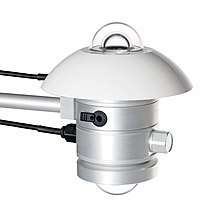Albedometer
An albedometer is an instrument used to measure the albedo (reflecting radiation) of a surface. An albedometer is mostly used to measure the reflectance of earths surface. Often it consists of two pyranometers: one facing up towards the sky and one facing down towards the surface. From the ratio of incoming and reflecting radiation the albedo can be calculated.

Measurement principle
The measurement of surface albedo of earths surface happens by using two pyranometers[1]. The upfacing pyranometer measures the incoming global solar radiation. The downward facing pyranometer measures the reflected global solar radiation. The ratio of the reflected to the global radiation is the solar albedo and depends on the properties of the surface and the directional distribution of the incoming solar radiation. Typical values range from 4%[2] for asphalt to 90%[3] for fresh snow.
Standards
References
- "Measurement instructions for albedo". Hukseflux. Archived from the original on 6 July 2018. Retrieved 29 June 2018.
- Sen, Sushobhan; Roesler, Jeffery (March 2016). "Aging albedo model for asphalt pavement surfaces". Journal of Cleaner Production. 117: 169–175. doi:10.1016/j.jclepro.2016.01.019. ISSN 0959-6526.
- "Thermodynamics: Albedo | National Snow and Ice Data Center". nsidc.org. Retrieved 2018-07-04.